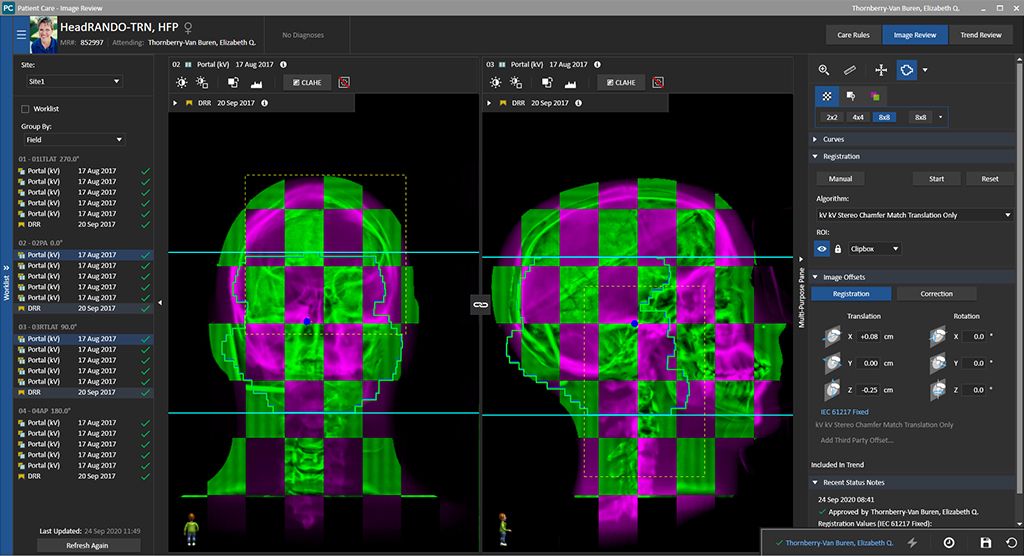Enhanced workflow visualization and streamlined care coordination keep busy radiotherapy clinics around the world running efficiently

MOSAIQ SmartClinic revolutionizes the oncology workflow
Collaboratively managing the patient’s cancer care journey and monitoring progress are essential for better outcomes and a positive patient experience. However, cumbersome documentation processes and manual workflows can hamper efficiency and contribute to treatment delays.
Today, oncology clinics across the world are tapping into the power of MOSAIQ® SmartClinic, Elekta’s mobile oncology, workflow management platform. The solution allows users to complete tasks, access information and monitor department workflows from any location. SmartClinic’s integration with MOSAIQ® Plaza provides users with unprecedented workflow efficiencies and a more streamlined working experience. Learn how three Elekta customers implemented SmartClinic and other Elekta software solutions to improve collaboration, better coordinate patient care and obtain more insights.
Illawarra Shoalhaven Local Health District Cancer Service: Preventing overlooked patients during the radiotherapy booking process
The Illawarra Shoalhaven Local Health District Cancer Service (ISLHD), New South Wales, Australia, began using MOSAIQ more than a decade ago. The cancer service consists of three facilities: a main site and two hub locations. In 2020, Elekta conducted an on-site demonstration of SmartClinic that impressed the ISLHD team.

“The features that interested us were the ability to create assessments on a tablet and electronic consent forms, which are saved directly into MOSAIQ and eliminate printing and scanning. The ability to receive and reply to QCLs remotely via smartphone or tablet and see a clear view of work in progress with SmartBoards also impressed us,” says Janet Kesby, Change Manager IT, Illawarra Shoalhaven Local Healthcare District Cancer Services.
ISLHD assembled a multidisciplinary SmartClinic committee to help guide implementation priorities. The committee took a focused approach, implementing just one functionality at first. “We wanted proof of concept that SmartClinic would work for us. We also didn’t have the dedicated staff to work full-time on the system and wanted to minimize disruption to the clinic staff’s workflow,” Kesby explains.
The initial project focused on streamlining radiotherapy bookings with a SmartBoard customized for the center’s radiation therapists. Radiotherapy scheduling can be complex and difficult to manage, especially for patients waiting for other treatments or workups, such as chemotherapy or fiducial markers.
The first step in developing the Radiotherapy Bookings SmartBoard was to clearly map out the existing workflow before planning the revised workflow. “The team really had to sort out the current workflow and understand differences between the breast and prostate cancer categories. It’s been an ongoing process to really customize the logic and the SmartBoard views for the radiation therapists,” says Laura Mahoney, Radiation Therapist, Illawarra Shoalhaven Local Healthcare District Cancer Services.
The radiation oncologist adds a care plan in the D&I screen which indicates the category they belong to. This then triggers the patient onto the Radiotherapy Bookings SmartBoard. In addition, QCLs are automatically generated in MOSAIQ through the logic from the board.
“The main benefit of the SmartBoard is that it’s virtually impossible for a patient to be missed during the booking process.”
“The main benefit of the SmartBoard is that it’s virtually impossible for a patient to be missed during the booking process, as we have minimized the doctor’s process to a single step,” Mahoney adds.
Based on initial implementation success, the ISLHD team is now looking to optimize the treatment planning and multidisciplinary team (MDT) meetings processes with SmartClinic.
5D Clinics: Implementing a comprehensive software package tailored to radiation oncology
5D Clinics, a private, standalone SRS and SBRT-based clinic in Perth, Western Australia, implemented SmartClinic in 2021.

“Our workforce is highly mobile, and this has been even more the case during COVID-19,” says Ben Hug, Principal Physicist with 5D Clinics. “We’re also preparing for expansion and satellite sites. We needed a scalable solution as well as workflow automation, an audit trail and better control of document generation.”
Seeking a software package tailored to radiation oncology, Hug turned to a comprehensive subscription-based software package, also known as SaaS, from Elekta. In addition to SmartClinic, the package included MOSAIQ Plaza capabilities such as paperless charting and a business and clinical intelligence application. Securely hosted in the Elekta Axis cloud with Microsoft Azure for data security and compliance, Elekta’s software package helps teams streamline more processes and obtain better insights through patient dashboards and operational data. The suite of solutions delivers the tools and connectivity across locations to support the 5D team’s expansion plans.
As a major component of the SaaS package, SmartClinic provides the workflow automation, mobility and document control 5D desired in a solution. Hug and the team appreciate SmartClinic’s visual display of patient progress, as well as the ability to access patient information and collaborate from any location, on any device. With limited internal IT resources and expertise, the cloud-based solution made sense for 5D Clinics, notes Hug.
5D Clinics has built several SmartBoards over the past year to visualize care plan progress and tasks, including treatment planning. Patients automatically appear on the clinic’s Treatment Planning SmartBoard once they have a CT planning appointment booked or an assessment in MOSAIQ. “Each task on the Treatment Planning SmartBoard must be manually approved or completed by the user,” says Hug. “At the end of this workflow, the patient moves to the Treatment SmartBoard, with some other checks before they hit the treatment bed.”

In addition to Treatment Planning and Treatment SmartBoards, the team has also created SmartBoards for bookings and new patient and follow-up consultations. “The new patient and follow-up consult workflow is an example of an Administration SmartBoard, where administration staff is required to collate relevant information like histology and imaging reports,” says Hug. He adds that interoperability components of this workflow include watches for the consultation date and shadow QCLs in MOSAIQ for people who prefer to do work through QCL lists.

SmartBoards: How to get started
Before building a SmartBoard, Hug recommends thinking through a few questions:
- What is the purpose of the SmartBoard?
- Who is going to use it?
- What will trigger patients to move onto and off of the board?
- How will the board interact with MOSAIQ?
- Are SmartBoard interactions automatic or manual?
- What happens at the end of the workflow? For example, is there interaction with other SmartBoards?
To help streamline clinical documentation, the 5D team relies on SmartForms within SmartClinic. So far, the team has developed a Treatment Planning SmartForm. “We have five or six QA sheets for treatment planning depending on the site that’s being treated, and we’ve collated them all into one dynamic treatment planning and quality assurance sheet,” says Hug.
The design of SmartForms ensures each question on a given form is based on the patient’s diagnosis and situation, actively changing the form as questions are answered. This eliminates the need to have different SmartForm versions for each cancer site.
“Building a SmartForm requires an investment of time and effort, but they’re really good for document control, which you may not have with an Excel workbook or storing a document on a shared drive,” notes Hug.
“It’s easy to think you can do everything in SmartClinic - and you probably can - but if you try to take on too much at the start, you may not execute to the highest standard that you need.”
Hug’s advice for implementing SmartClinic is to start small. “It’s easy to think you can do everything in SmartClinic - and you probably can - but if you try to take on too much at the start, you may not execute to the highest standard that you need,” he says.
To iron out the hiccups, Hug says that it is important to conduct thorough planning and testing in the test environment before you move into production. Finally, Hug says that making changes to your SmartBoards and SmartForms is inevitable. However, he advises running with changes for at least a couple of weeks before making additional adjustments.
Generations Radiotherapy & Oncology PC: Going deeper with SmartClinic
Generations Radiotherapy & Oncology PC (GenXRT) in Alabaster, Alabama, is the second center in the world to implement SmartClinic. From the outset, Elekta’s collaborative approach to customer relationships stood out to GenXRT Radiation Oncologist, Christopher Jahraus, MD, FACRO.

“When I bought my practice almost 10 years ago, we found Elekta to be a vendor that was very interested in us uniquely,” says Dr. Jahraus. “They didn’t try to tell us exactly what we ought to do, but said, ‘How do you want to do things and how can we help you achieve your goals?’”
GenXRT initially turned to SmartClinic to improve clinical documentation efficiency. Prior to implementing SmartClinic, fewer than 50 percent of on-treatment visit notes were completed within 24 hours. After implementing the solution, that number jumped to 96 percent, with most of the notes completed during the patient encounter.
Today, the practice uses several SmartForms that are customized to the clinic’s unique workflows. Dr. Jahraus appreciates the dynamic nature of the forms as well as the ability to streamline documentation and communications.
“We used to have a filing cabinet full of individual forms and would have to pull the right one for the situation. No longer is that the case,” says Dr. Jahraus. “My practice is thrilled to be able to advance our use of SmartForms.”
GenXRT is working on transitioning all of its patient intake paperwork to SmartClinic. Ultimately, the goal is to complete a majority of physician and team member documentation in SmartClinic. “That’s an exciting and very real goal that we will be able to achieve,” adds Dr. Jahraus.
SmartBoards are a vital tool for visualizing care plan progress and tasks and coordinating efforts across the department at GenXRT. “One of the most unique features of SmartBoards is that you can track any process through radiotherapy. You can also have what we call ‘watchers,’ where SmartClinic will determine when a patient should be put on a certain board. For instance, if the Simulation Board is complete, SmartClinic will drop the patient onto the Dosimetry Board so that the process flows smoothly,” he notes.
SmartClinic comes with a standard database of five common oncology SmartBoard workflows, including simulation to treatment and authorization process. Clinics can customize these boards and create additional boards. “SmartBoards are endlessly configurable,” comments Dr. Jahraus. “They allow you to document and track progress every step of the way - from treatment to billing.”
As a long-time SmartClinic user, Dr. Jahraus sits on Elekta’s Customer Advisory Council, a group of SmartClinic users that includes physicians, physicists, practice administrators and others. The council proposes changes and improvements to SmartClinic based on day-to-day experience with the platform. Dr. Jahraus feels user feedback leads to a much better product.
“I’ve seen ideas we proposed in the Customer Advisory Council incorporated into a new version of SmartClinic within just a few months,” he says. “On-the-ground users are helping to direct advancements with SmartClinic and that’s tremendously exciting to me.”
“There are astoundingly brilliant people at Elekta who are able to take your SmartClinic vision and put it into practice.”
When considering whether SmartClinic is right for your center, Dr. Jahraus advises analyzing areas of your practice that require improvement. Then, think about how SmartClinic might address those needs. He also suggests developing a detailed plan for the SmartBoards and SmartForms you would like to create before the Elekta implementation team arrives. “There are astoundingly brilliant people at Elekta who are able to take your SmartClinic vision and put it into practice. So take advantage of that by planning,” says Dr. Jahraus





